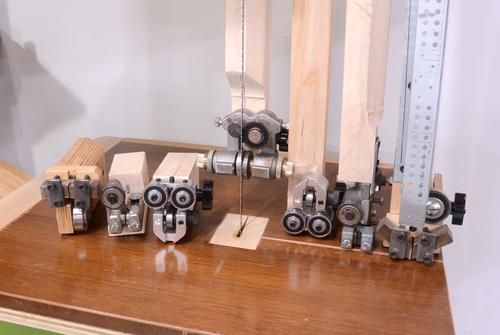 I use homemade
blade guides
for all my homemade bandsaws. But at this point, I also
had three different commercially made blade guides, and I figured it would be interesting
to compare them all, on the same bandsaw.
I use homemade
blade guides
for all my homemade bandsaws. But at this point, I also
had three different commercially made blade guides, and I figured it would be interesting
to compare them all, on the same bandsaw.
 I use homemade
blade guides
for all my homemade bandsaws. But at this point, I also
had three different commercially made blade guides, and I figured it would be interesting
to compare them all, on the same bandsaw.
I use homemade
blade guides
for all my homemade bandsaws. But at this point, I also
had three different commercially made blade guides, and I figured it would be interesting
to compare them all, on the same bandsaw.
I made mounts for the commercial blade guides so I could try them all on my big bandsaw. I ended up making new guide posts for each upper blade guide for the experiment.
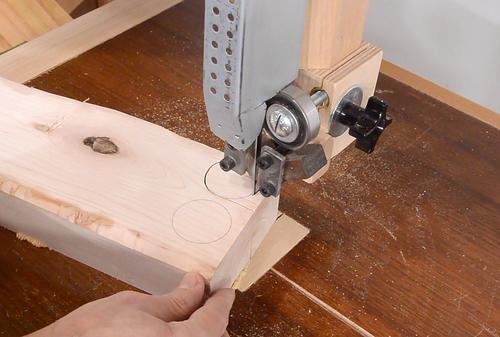
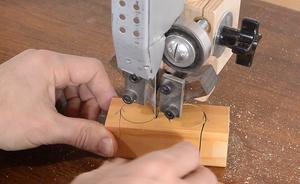 The first test was with my homemade blade guides. I cut some small circles
both clockwise and counter clockwise, in some pine and some silver maple.
The first test was with my homemade blade guides. I cut some small circles
both clockwise and counter clockwise, in some pine and some silver maple.
I'm using a 1/4" (6 mm) wide blade, because, I find narrow blades are harder to guide than wider ones.
The homemade guides worked as they always do, I'm used to them, not much to say.
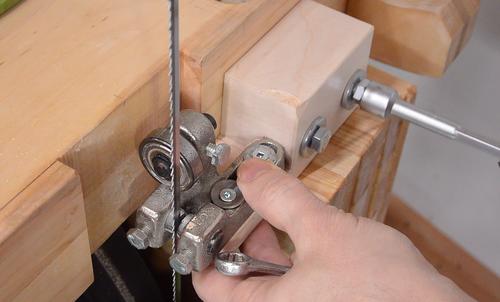
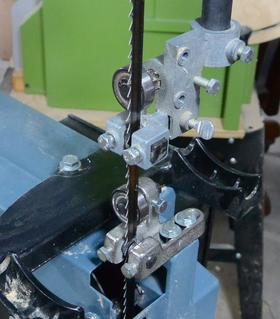 Next I installed the blade guides borrowed from my
cast iron bandsaw. Here mounting the lower blade
guide that goes below the table.
Next I installed the blade guides borrowed from my
cast iron bandsaw. Here mounting the lower blade
guide that goes below the table.
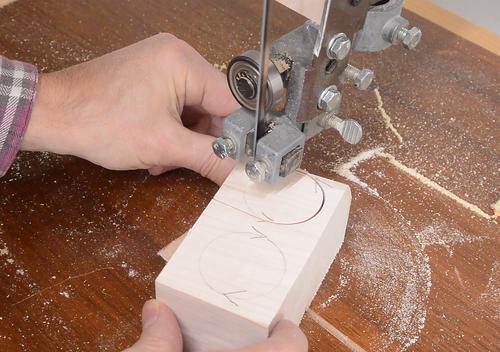 Making the same cuts, from the same piece of wood. Again, nothing unusual.
Although, with the upper blade guide this small, and no blade guard in place,
visibility was really good.
Making the same cuts, from the same piece of wood. Again, nothing unusual.
Although, with the upper blade guide this small, and no blade guard in place,
visibility was really good.
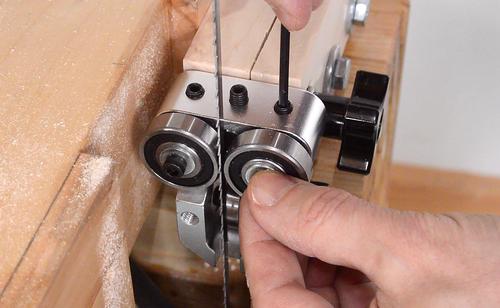 Next using some aftermarket blade guides, these ones from sawblade.com
(some of these),
though they look just like the ones from carterproducts.com.
They are nice and shiny and feel solid, though getting the adjustment right with the
rollers was kind of annoying, especially because none of my Allen keys fit the set
screws quite right. I also wasn't sure how tight to make them on the blade.
I wanted the rollers to touch the blade, but not pinch it and spin constantly. This
was very fiddly.
Next using some aftermarket blade guides, these ones from sawblade.com
(some of these),
though they look just like the ones from carterproducts.com.
They are nice and shiny and feel solid, though getting the adjustment right with the
rollers was kind of annoying, especially because none of my Allen keys fit the set
screws quite right. I also wasn't sure how tight to make them on the blade.
I wanted the rollers to touch the blade, but not pinch it and spin constantly. This
was very fiddly.
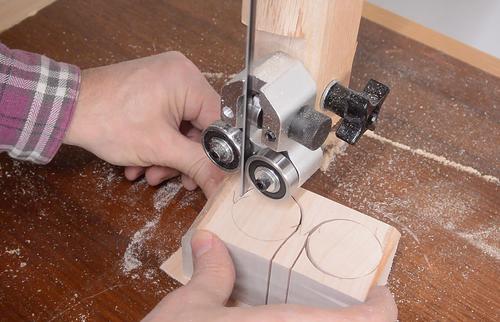 The guides performed nicely, making a nice whizzing sound, but using them
was no different from using the other two guides that I tried.
The guides performed nicely, making a nice whizzing sound, but using them
was no different from using the other two guides that I tried.
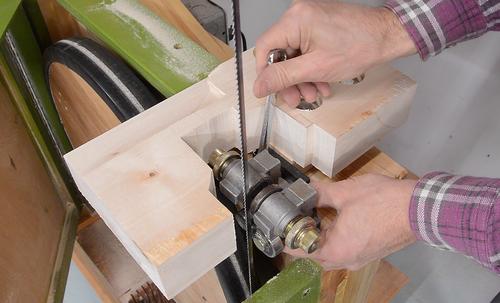 Then trying some big blade guides that a reader from western Canada sent me.
He upgraded the blade guides on his big bandsaw to ones from Carter.
Then trying some big blade guides that a reader from western Canada sent me.
He upgraded the blade guides on his big bandsaw to ones from Carter.
These guides are kind of large and wouldn't fit next to the trunnion support beam on my bandsaw. So I had to make a new temporary table support just to make room for them.
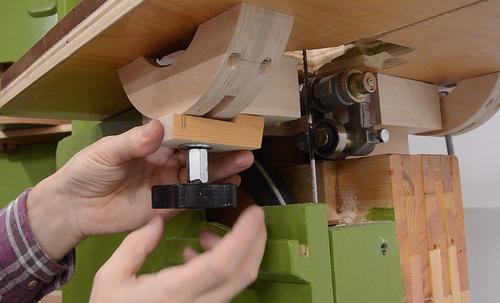 I opted not to make trunnions for this test. Instead I used the screws
and knobs just as clamps to hold the table on. Not the most secure, but it was only
for one experiment.
I opted not to make trunnions for this test. Instead I used the screws
and knobs just as clamps to hold the table on. Not the most secure, but it was only
for one experiment.
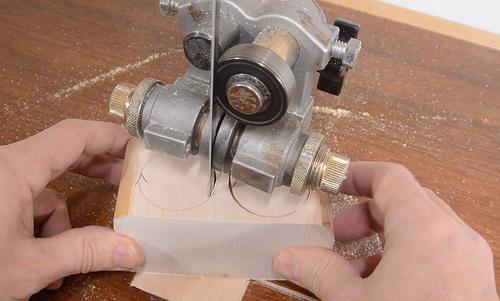 The guides were kind of annoying to adjust to be really close. The pads on the guides
can rotate, but if they bind with the blade, they can push the blade forward as
they turn. Once set up, they worked as well as
the other three blade guides. These guides were designed to be used with
much wider blades.
The guides were kind of annoying to adjust to be really close. The pads on the guides
can rotate, but if they bind with the blade, they can push the blade forward as
they turn. Once set up, they worked as well as
the other three blade guides. These guides were designed to be used with
much wider blades.
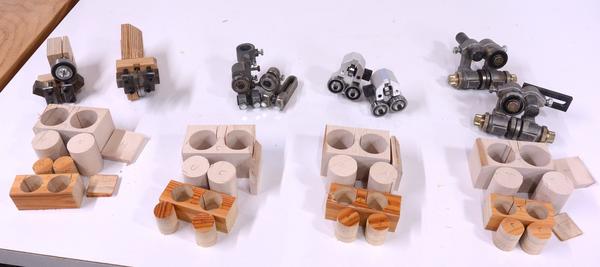 And here's all the blade guides and samples that I cut with them.
And here's all the blade guides and samples that I cut with them.
But I found the shiny fancy guides from sawblade.com also quite annoying to adjust. The bearings are adjusted by turning the eccentric mount they are on, then tightening the set screw to lock them - same approach for both sides and the thrust bearing on the back. I fiddled around with them quite a bit. With guide blocks, I just push them lightly against the blade and tighten them, then make sure the blade slides easily, but if I did that with the rollers, the rollers end up spinning all the time.
The big guides from Ted (right-most above) have nice knobs on either side, plus a locking ring. So large adjustments are quite nice. But getting the guides to just touch the blade and rub lightly was fiddly to get right, so also kind of annoying.
The cheap blade guides from my 14" bandsaw were the easiest to adjust. The screws are on the front, loosen it, lightly push the blocks against the blade, and tighten again.
That said, the homemade blade guides, and the ones from Ted can take much wider blades than the ones from my 14" bandsaw or the sawblade.com ones. The guides from Ted could also handle a 1 1/4" wide sawmill blade.
Looks matter because, with no actual difference in performance, how good a set of guides is is largely a psychological factor. So guides that look cooler are just perceived to be better, and as a result you may well end up doing better work. Not unlike how looks are important for musical instruments.
I have reservations about the fancy ball bearing guides. I When cutting soft wood, I could see some gunk starting to build up on the rollers, though the gunk came off on its own. The problem I see is, especially for the lower guides, as sawdust falls on them from the blade, they roll and press it onto the blade. Of course, I could leave a bit of space between the blade and the rollers to prevent that, but if there is a gap, then the guides aren't effectively guiding the blade. When I initially used roller skate bearings as guides for my first first homemade bandsaw, they were quite noisy. But these are larger ball bearings, higher quality, and new, so I didn't notice them making a lot of noise.
Overall, it makes me feel better about the blade guides on my old cast iron 14" bandsaw, and the guides on my homemade bandsaws. The homemade guides work just as well, and, surprisingly, aren't any more annoying to adjust than the fancy aftermarket blade guides or the big guides that Ted sent me.
I'd say, unless there is something really wrong with the blade guides on your bandsaw, don't replace them. A properly adjusted set of blade guides will guide the blade perfectly well, and a fancy aftermarket guides don't improve on that.
See also: